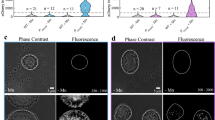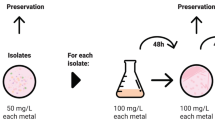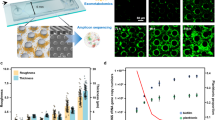Abstract
Manganese (Mn) is an important metal in geochemical cycles. Some microorganisms can oxidize Mn(II) to Mn oxides, which can, in turn, affect the global cycles of other elements by strong sorption and oxidation effects. Microbe–microbe interactions have important roles in a number of biological processes. However, how microbial interactions affect Mn(II) oxidation still remains unknown. Here, we investigated the interactions between two bacteria (Arthrobacter sp. and Sphingopyxis sp.) in a co-culture, which exhibited Mn(II)-oxidizing activity, although neither were able to oxidize Mn(II) in isolation. We demonstrated that the Mn(II)-oxidizing activity in co-culture was most likely induced via contact-dependent interactions. The expressed Mn(II)-oxidizing protein in the co-culture was purified and identified as a bilirubin oxidase belonging to strain Arthrobacter. Full sequencing of the bilirubin oxidase-encoding gene (boxA) was performed. The Mn(II)-oxidizing protein and the transcripts of boxA were detected in the co-culture, but not in either of the isolated cultures. This indicate that boxA was silent in Arthrobacter monoculture, and was activated in response to presence of Sphingopyxis in the co-culture. Further, transcriptomic analysis by RNA-Seq, extracellular superoxide detection and cell density quantification by flow cytometry indicate induction of boxA gene expression in Arthrobacter was co-incident with a stress response triggered by co-cultivation with Sphingopyxis. Our findings suggest the potential roles of microbial physiological responses to stress induced by other microbes in Mn(II) oxidation and extracellular superoxide production.
Similar content being viewed by others
Log in or create a free account to read this content
Gain free access to this article, as well as selected content from this journal and more on nature.com
or
Accession codes
References
Adams LF, Ghiorse WC . (1985). Influence of manganese on growth of a sheathless strain of Leptothrix-discophora. Appl Environ Microbiol 49: 556–562.
Andeer PF, Learman DR, Mcilvin M, Dunn JA, Hansel CM . (2015). Extracellular haem peroxidases mediate Mn(II) oxidation in a marine Roseobacter bacterium via superoxide production. Environ Microbiol 17: 3925–3936.
Anderson CR, Johnson HA, Caputo N, Davis RE, Torpey JW, Tebo BM . (2009). Mn(II) oxidation is catalyzed by heme peroxidases in 'Aurantimonas manganoxydans' strain SI85-9A1 and Erythrobacter sp strain SD-21. Appl Environ Microbiol 75: 4130–4138.
Banh A, Chavez V, Doi J, Nguyen A, Hernandez S, Ha V et al. (2013). Manganese (Mn) oxidation increases intracellular Mn in Pseudomonas putida GB-1. Plos One 8: 8.
Bromfield SM, Skerman VBD . (1950). Biological oxidation of manganese in soils. Soil Science 69: 337–347.
Bromfield SM . (1956). Oxidation of manganese by soil microorganisms. Aust J Biol Sci 9: 238–252.
Butterfield CN, Soldatova AV, Lee SW, Spiro TG, Tebo BM . (2013). Mn(II, III) oxidation and MnO2 mineralization by an expressed bacterial multicopper oxidase. Proc Natl Acad Sci USA 110: 11731–11735.
Christodoulou DC, Gorham JM, Herman DS, Seidman JG . (2011). Construction of normalized RNA-seq libraries for next-generation sequencing using the crab duplex-specific nuclease. Curr Protoc Mol Biol 94: 4.12.1–4.12.11.
Clement BG . (2006). Biological Mn(II) oxidation in freshwater and marine systems: new perspectives on reactants, mechanisms and microbial catalysts of Mn cycling in the environment. Ph.D. Thesis. UC San Diego: b6635280.
Conesa A, Gotz S, Garcia-Gomez J, Terol J, Talon M, Robles M . (2005). Blast2GO: a universal tool for annotation, visualization and analysis in functional genomics research. Bioinformatics 21: 3674–3676.
Corstjens PLAM, De Vrind JPM, Goosen T, De Vrind-de Jong EW . (1997). Identification and molecular analysis of the Leptothrix discophora SS-1 mofA gene, a gene putatively encoding a manganese-oxidizing protein with copper domains. Geomicrobiol J 14: 91–108.
Dick GJ, Torpey JW, Beveridge TJ, Tebo BM . (2008a). Direct identification of a bacterial manganese(II) oxidase, the multicopper oxidase MnxG, from spores of several different marine Bacillus species. Appl Environ Microbiol 74: 1527–1534.
Dick GJ, Podell S, Johnson HA, Rivera-Espinoza Y, Bernier-Latmani R, McCarthy JK et al. (2008b). Genomic insights into Mn(II) oxidation by the marine Alphaproteobacterium Aurantimonas sp. strain SI85-9A1. Appl Environ Microbiol 74: 2646–2658.
Dong TG, Dong SQ, Catalano C, Moore R, Liang XY, Mekalano JJ . (2015). Generation of reactive oxygen species by lethal attacks from competing microbes. Proc Natl Acad Sci USA 112: 2181–2186.
Dubinina G, Zhdanov AV . (1975). Recognition of the iron bacteria ‘Siderocapsa’ as Arthrobacters and description of Arthrobacter siderocapsulatus sp. nov. Int J Syst Bacteriol 25: 340–350.
Ehrlich HL . (1971). Bacteriology of manganese nodules. V. Effect of hydrostatic pressure on bacterial oxidation of MnII and reduction of MnO2 . Appl Microbiol 21: 306–310.
Forrez I, Carballa M, Verbeken K, Vanhaecke L, Schlusener M, Ternes T et al. (2010). Diclofenac oxidation by biogenic manganese oxides. Environ Sci Technol 44: 3449–3454.
Godrant A, Rose AL, Sarthou G, Waite TD . (2009). New method for the determination of extracellular production of superoxide by marine phytoplankton using the chemiluminescence probes MCLA and red-CLA. Limnol Oceanogr: Methods 7: 682–692.
Gupta R, Schuster M . (2013). Negative regulation of bacterial quorum sensing tunes public goods cooperation. ISME J 7: 2159–2168.
Haas BJ, Papanicolaou A, Yassour M, Grabherr M, Blood PD, Bowden J et al. (2013). De novo transcript sequence reconstruction from RNA-seq using the Trinity platform for reference generation and analysis. Nat Protoc 8: 1494–1512.
Kimura ZI, Okabe S . (2013). Acetate oxidation by syntrophic association between Geobacter sulfurreducens and a hydrogen-utilizing exoelectrogen. ISME J 7: 1472–1482.
Krumbein WE, Altmann HJ . (1973). A new method for the detection and enumeration of manganese oxidizing and reducing microorganisms. Helgol Wiss Meeresunt 25: 347–356.
Learman DR, Voelker BM, Vazquez-Rodriguez AI, Hansel CM . (2011). Formation of manganese oxides by bacterially generated superoxide. Nat Geosci 4: 95–98.
Li B, Dewey CN . (2011). RSEM: accurate transcript quantification from RNA-Seq data with or without a reference genome. BMC Bioinformatics 12: 93–99.
Li JX, Gu JD . (2007). Complete degradation of dimethyl isophthalate requires the biochemical cooperation between Klebsiella oxytoca Sc and Methylobacterium mesophilicum Sr isolated from wetland sediment. Sci Total Environ 380: 181–187.
Liang JS, Bai YH, Hu CZ, Qu JH . (2016). Cooperative Mn(II) oxidation between two bacterial strains in an aquatic environment. Water Res 89: 252–260.
Men Y, Feil H, VerBerkmoes NC, Shah MB, Johnson DR, Lee PKH et al. (2012). Sustainable syntrophic growth of Dehalococcoides ethenogenes strain 195 with Desulfovibrio vulgaris Hildenborough and Methanobacterium congolense: global transcriptomic and proteomic analysis. ISME J 6: 410–421.
Miller MB, Bassler BL . (2001). Quorum sensing in bacteria. Annu Rev Microbiol 55: 165–199.
Morgan JJ . (2005). Kinetics of reaction between O2 and Mn(II) species in aqueous solutions. Geochim Cosmochim Ac 69: 35–48.
Mougous JD, Cuff ME, Raunser S, Shen A, Zhou M, Gifford CA et al. (2006). A virulence locus of Pseudomonas aeruginosa encodes a protein secretion apparatus. Science 312: 1526–1530.
Netzker T, Fischer J, Weber J, Mattern DJ, Konig CC, Valiante V et al. (2015). Microbial communication leading to the activation of silent fungal secondary metabolite gene clusters. Front Microbiol 6: 299.
Nutzmann HW, Reyes-Dominguez Y, Scherlach K, Schroeckh V, Horn F, Gacek A et al. (2011). Bacteria-induced natural product formation in the fungus Aspergillus nidulans requires Saga/Ada-mediated histone acetylation. Proc Natl Acad Sci USA 108: 14282–14287.
Onaka H, Mori Y, Igarashi Y, Furumai T . (2011). Mycolic acid-containing bacteria induce natural-product biosynthesis in Streptomyces species. Appl Environ Microbiol 77: 400–406.
Pukatzki S, Ma AT, Sturtevant D, Krastins B, Sarracino D, Nelson WC et al. (2006). Identification of a conserved bacterial protein secretion system in Vibrio cholerae using the Dictyostelium host model system. Proc Natl Acad Sci USA 103: 1528–1533.
Rambow-Larsen AA, Weiss AA . (2002). The PtlE protein of Bordetella pertussis has peptidoglycanase activity required for Ptl-mediated pertussis toxin secretion. J Bacteriol 184: 2863–2869.
Ridge JP, Lin M, Larsen EI, Fegan M, McEwan AG, Sly LI . (2007). A multicopper oxidase is essential for manganese oxidation and laccase-like activity in Pedomicrobium sp ACM 3067. Environ Microbiol 9: 944–953.
Robinson MD, Mccarthy DJ, Smyth GK . (2010). edgeR: a bioconductor package for differential expression analysis of digital gene expression data. Bioinformatics 26: 139–140.
Russell AB, Hood RD, Bui NK, LeRoux M, Vollmer W, Mougous JD . (2011). Type VI secretion delivers bacteriolytic effectors to target cells. Nature 475: U343–U392.
Schroeckh V, Scherlach K, Nutzmann HW, Shelest E, Schmidt-Heck W, Schuemann J et al. (2009). Intimate bacterial-fungal interaction triggers biosynthesis of archetypal polyketides in Aspergillus nidulans. Proc Natl Acad Sci USA 106: 14558–14563.
Su J, Bao P, Bai T, Deng L, Wu H, Liu F et al. (2013). CotA, a multicopper oxidase from Bacillus pumilus WH4, exhibits manganese-oxidase activity. Plos One 8: e60573.
Su JM, Deng L, Huang LB, Guo SJ, Liu F, He J . (2014). Catalytic oxidation of manganese(II) by multicopper oxidase CueO and characterization of the biogenic Mn oxide. Water Res 56: 304–313.
Summers ZM, Fogarty HE, Leang C, Franks AE, Malvankar NS, Lovley DR . (2010). Direct exchange of electrons within aggregates of an evolved syntrophic co-culture of anaerobic bacteria. Science 330: 1413–1415.
Sunda WG, Kieber DJ . (1994). Oxidation of humic substances by manganese oxides yields low-molecular-weight organic substrates. Nature 367: 62–64.
Tebo BM, Webb SM, Dick GJ, Bargar JR . (2005). Evidence for the presence of Mn(III) intermediates in the bacterial oxidation of Mn(II). Proc Natl Acad Sci USA 102: 5558–5563.
Toner B, Manceau A, Webb SM, Sposito G . (2006). Zinc sorption to biogenic hexagonal-birnessite particles within a hydrated bacterial biofilm. Geochim Cosmochim Ac 70: 27–43.
Villalobos M, Bargar J, Sposito G . (2005). Mechanisms of Pb(II) sorption on a biogenic manganese oxide. Environ Sci Technol 39: 569–576.
Walker CB, He Z, Yang ZK, Ringbauer JA, He Q, Zhou J et al. (2009). The electron transfer system of syntrophically grown Desulfovibrio vulgaris. J Bacteriol 191: 5793–5801.
Wallden K, Rivera-Calzada A, Waksman G . (2010). Type IV secretion systems: versatility and diversity in function. Cell Microbiol 12: 1203–1212.
Wintermute EH, Silver PA . (2010). Emergent cooperation in microbial metabolism. Mol Syst Biol 6: 407–413.
Wittig I, Braun HP, Schagger H . (2006). Blue native PAGE. Nat Protoc 1: 418–428.
Zelezniak A, Andrejev S, Ponomarova O, Mende DR, Bork P, Patil KR . (2015). Metabolic dependencies drive species co-occurrence in diverse microbial communities. Proc Natl Acad Sci USA 112: 6449–6454.
Acknowledgements
This study was supported by a major program (51290282), a general program (51578537) and a major international (regional) joint research project (51420105012) granted by the National Natural Science Foundation of China. We thank Xianbin Meng, Yisheng Xu, Jin Li and Haiteng Deng in Center of Biomedical Analysis, Tsinghua University for analysis of protein MS/MS data, and Junying Jia in Core Facility for Protein Research, Institute of Biophysics, Chinese Academy of Sciences for technical assistance in flow cytometry assay. We thank the anonymous reviewers for their highly constructive comments.
Author contributions
JSL, YHB and JHQ designed experiments. JSL and YHB analyzed data. Experiments were conducted by JSL. The manuscript was written by JSL and YHB, with contributions from YJM and JHQ.
Author information
Authors and Affiliations
Corresponding author
Ethics declarations
Competing interests
The authors declare no conflict of interest.
Additional information
Supplementary Information accompanies this paper on The ISME Journal website
Supplementary information
Rights and permissions
About this article
Cite this article
Liang, J., Bai, Y., Men, Y. et al. Microbe–microbe interactions trigger Mn(II)-oxidizing gene expression. ISME J 11, 67–77 (2017). https://doi.org/10.1038/ismej.2016.106
Received:
Revised:
Accepted:
Published:
Issue date:
DOI: https://doi.org/10.1038/ismej.2016.106
This article is cited by
-
Microbiologically influenced corrosion of AISI 202 and 316L stainless steels under manganese-oxidizing biofilms
3 Biotech (2024)
-
Light-independent anaerobic microbial oxidation of manganese driven by an electrosyntrophic coculture
The ISME Journal (2023)
-
Association between blood heavy metal concentrations and skin cancer in the National Health and Nutrition Examination Survey, 2011–2018
Environmental Science and Pollution Research (2023)
-
The initial inoculation ratio regulates bacterial coculture interactions and metabolic capacity
The ISME Journal (2021)
-
Manganese-oxidizing microbes and biogenic manganese oxides: characterization, Mn(II) oxidation mechanism and environmental relevance
Reviews in Environmental Science and Bio/Technology (2020)



